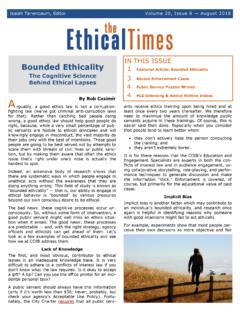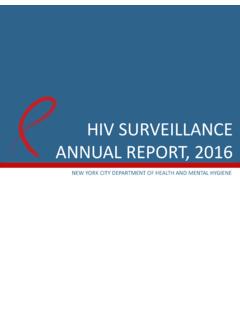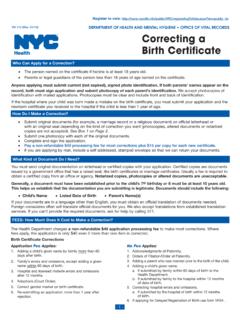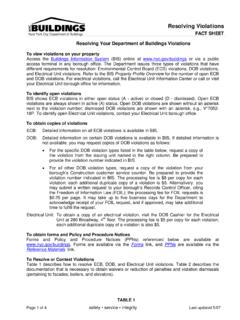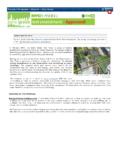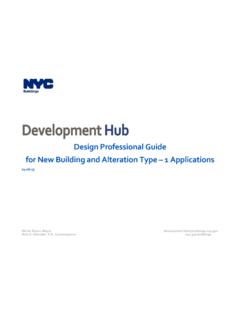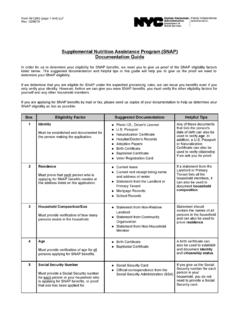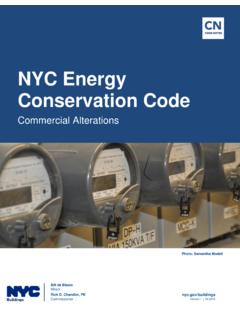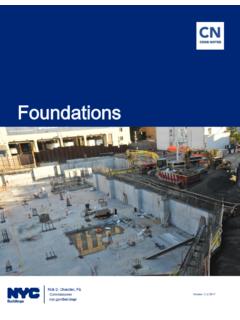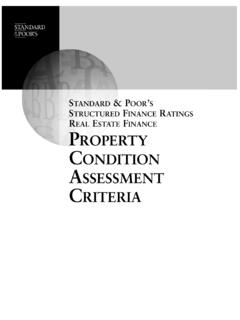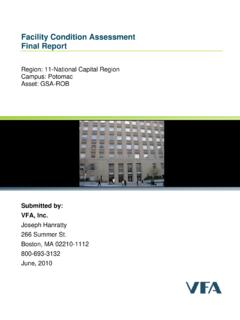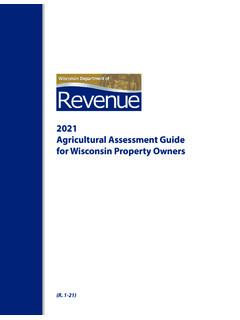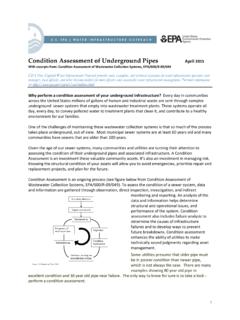Transcription of STRUCTURAL CONDITION ASSESSMENT AS A TOOL FOR …
1 Presented by Dan Eschenasy, , , SECB STRUCTURAL CONDITION ASSESSMENT AS A TOOL FOR SAFE CONSTRUCTION COPYRIGHT MATERIALS This presentation is protected by US and International Copyright laws. Reproduction, distribution, display and use of the presentation without written permission of the Department is prohibited. The information in this presentation is current only as of the copyright date of this presentation. This presentation is not a substitute for any law, rule or regulation. The City disclaims any liability for errors that may be contained herein and shall not be responsible for any damages, consequential or actual, arising out of or in connection with the use of this information.
2 2 2019 New York City Department of Buildings DESCRIPTION The presentation reviews the methods of STRUCTURAL CONDITION ASSESSMENT of existing buildings as they relate to issues faced by engineers during the design and construction in a dense building neighborhood. The use of CONDITION ASSESSMENT findings in the design of demolition and underpinning activities will be reviewed. 3 LEARNING OBJECTIVES At the end of this presentation, you will be able to: the principles and methodologies of STRUCTURAL CONDITION ASSESSMENT as a tool for the design of construction operations and monitor building response. about the NYC Building Code Chapters 17 and 33 requirements to protect adjoining structures during construction.
3 How STRUCTURAL CONDITION ASSESSMENT can be structured to respond to specific project conditions and construction activities. and will be able to identify use of STRUCTURAL CONDITION ASSESSMENT for demolition and underpinning design. 4 NYC ADMINISTRATIVE CODE CHAPTER 3 MAINTENANCE OF BUILDINGS CONDITION ASSESSMENT RETAINING WALLS CONDITION ASSESSMENT requirements. A CONDITION ASSESSMENT of a retaining wall shall be conducted at periodic intervals as set forth by rule of the commissioner, but such ASSESSMENT shall be conducted at least once every 5 years. 5 NOTE: NYC Building Code does not use the term CONDITION ASSESSMENT often FACADES 1 RCNY 103-04 Critical examination.
4 An examination conducted to review the exterior of a building and all parts thereof to determine whether the exterior walls (fa ades) and the appurtenances thereto are either safe, unsafe, or safe with a repair and maintenance program and whether, in the judgment of a Qualified Exterior Wall Inspector, they require remedial work. The QEWI shall utilize a professional standard of care to assess the building s CONDITION , including splitting or fracturing of terra cotta on buildings, ..the cause of these and such other conditions detected. The QEWI shall order any special or additional inspections and/or tests that may be required to support investigations and to determine the causes of any defects.
5 6 ENTIRE VILLAGE 7 The entire community participated in the erection of a building. CURRENT DENSITY 8 Construction often occurs in tight lots next to very old buildings. STANDARDS AND REFERENCES ASCE 11 Guideline for STRUCTURAL CONDITION ASSESSMENT of Existing Buildings ASCE 30 Guideline for CONDITION ASSESSMENT of the Building Envelope Masonry Society Guide for CONDITION ASSESSMENT of Masonry Fa ades ASCE 31 Seismic Evaluation of Existing Buildings 9 STANDARDS AND REFERENCES (continued) ATC-45 Safety Evaluation of Buildings after Windstorms and Floods ASTM E2018 Standard Guide for Property CONDITION Assessments ACI 562 - Code Requirements for ASSESSMENT , Repair, and Rehabilitation of Existing Concrete Structures 10 ASCE/SEI 11 - DEFINITION Systematic collection and analysis of data, evaluation, and recommendations regarding the portions of an existing structure which would be affected by its proposed use.
6 11 PURPOSE OF ASSESSMENT Per ASCE 11 CONDITION ASSESSMENT of an existing building envelope may be undertaken for a number of purposes a performance report establishing building serviceability planning for maintenance or repair Code compliance life safety, durability historic preservation or a number of special purposes based on the specific building and its current or proposed occupancy or function 12 CONCRETE POURED AGAINST MASONRY 13 BUILDINGS BULLETIN 2009-011 requires Evaluation of Supporting Structure When Placing Concrete EVALUATION The emphasis of the evaluation is directed by the PURPOSE of the investigation Safety/integrity of existing buildings or work area during construction as a result of construction TO MAKE INFORMED DECISIONS 14 TYPES OF ASSESSMENT Cursory ASSESSMENT .
7 This is a visual overview of the general CONDITION of the building envelope. It is often used for screening multiple buildings to establish priorities for maintenance and repair or further study. Preliminary ASSESSMENT : The preliminary CONDITION ASSESSMENT is usually limited in scope. It will consist of a site visit for familiarization and to identify problem areas, a review of available documents, an interview of involved parties, and a preliminary report of findings and recommendations. Detailed ASSESSMENT : This is an expansion of the preliminary ASSESSMENT . It will include a review of documentation, component classification, field investigation, testing, analysis, and report.
8 Safety: There are numerous types of circumstances that present a potential hazard to the safety of the personnel involved. 15 ASSESSMENT PURPOSE AND CRITERIA ASTM-E-2018-15 The goal is to identify and communicate physical deficiencies to a user. The term physical deficiencies includes the presence of conspicuous defects and material deferred maintenance of a subject property s material systems, components, or equipment as observed during completion of the property CONDITION ASSESSMENT . This definition specifically excludes deficiencies that may be remedied with routine maintenance, miscellaneous minor repairs, normal operating maintenance.
9 16 CONDITION REPORTS: CRITERIA LIST REQUIRED Good CONDITION in working CONDITION and does not require immediate or short term repairs above an agreed threshold. Fair CONDITION in working CONDITION , but may require immediate or short term repairs above an agreed threshold Poor CONDITION not in working CONDITION or requires immediate or short term repairs substantially above an agreed threshold From ASTM E 2018 15 Standard Guide for Property CONDITION Assessments: Baseline Property CONDITION ASSESSMENT Process 17 ACI 562 - CODE REQUIREMENTS FOR ASSESSMENT , REPAIR & REHABILITATION OF EXISTING CONCRETE STRUCTURES Unsafe STRUCTURAL conditions for gravity and wind loads Substantial STRUCTURAL damage to vertical members of the lateral-force resisting system Substantial STRUCTURAL damage to vertical members of the gravity-load resisting system Damage less than substantial STRUCTURAL damage, deterioration and faulty construction with capacity increase Damage less than substantial STRUCTURAL damage.
10 Deterioration and faulty construction without capacity increase 18 PERSONNEL QUALIFICATIONS All personnel involved in the ASSESSMENT shall possess the technical qualifications, including practical experience, education and professional judgment required to perform the individual technical tasks assigned. Interpretation of results and conclusions shall be performed by a design professional qualified in the appropriate discipline. 19 DEFECT vs. DETERIORATION A defect is the nonconformity of a component with a standard or specified characteristic. Defects may be introduced through poor design, manufacturing, fabrication, or construction before a structure begins its service life and (less frequently) by inappropriate operations and maintenance during its service life.
